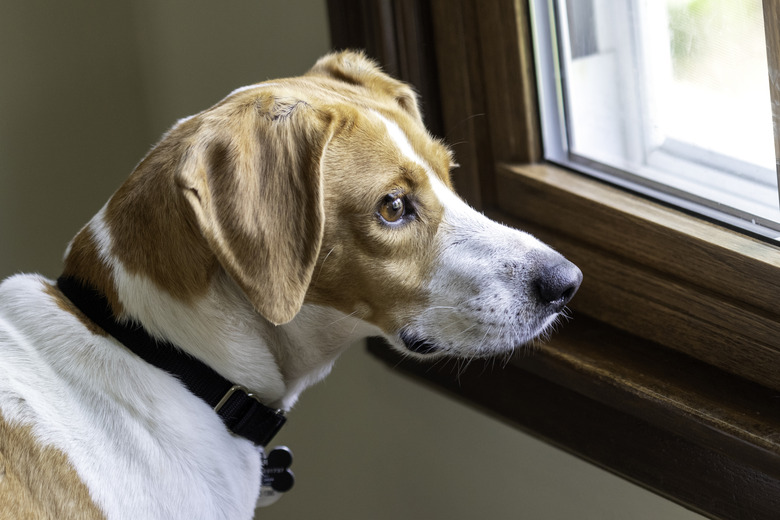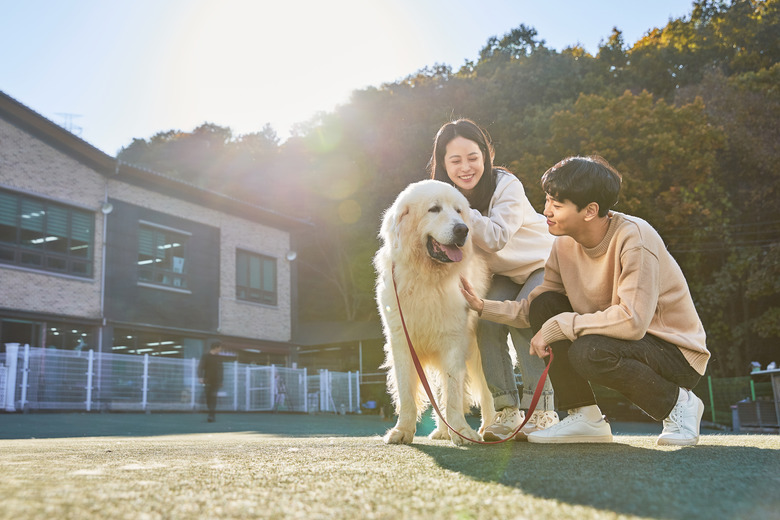How To Treat A Dog Rash Around The Eye
We spoke with Dr. Shagufta Mulla, a veterinarian with a DVM degree from Colorado State University with 20 years of experience as a small animal veterinarian, and learned that anytime your dog develops a rash, it's something you should take seriously. You might notice that your dog starts to scratch at the rash if they're experiencing discomfort or itchiness, and that might lead to other skin problems, such as hot spots and skin infections.
While any rash should be addressed, when one occurs in the area around your dog's eye, it becomes an even bigger priority. That's because your pet might end up pawing at it to the point that they cause further trauma to the skin around the eye, or they might even end up scratching the cornea of the eye, causing an ulcer.
The good news is that there are things you can do to treat a rash near your dog's eye. Here are the basic steps you can take to help your pet's skin heal.
Have your veterinarian examine your dog
Have your veterinarian examine your dog
Your veterinarian can examine the rash around your dog's eye and talk to you about other symptoms your pet is experiencing, such as hair loss or itchiness. "One sign that your dog scratched his cornea is that they will squint or hold that eye shut, which is a sign of pain," notes Dr. Mulla.
To provide an accurate diagnosis and treatment plan, your veterinarian may look for skin abnormalities and might run some tests, such as a biopsy or blood test, to figure out the underlying cause of the rash.
They may also check for signs of an insect bite or foreign body that might be to blame for the skin irritation. If the eye is affected and causing your dog to paw at the area, your veterinarian might want to rule out conditions like conjunctivitis (pink eye) or dry eye.
There are myriad causes for rashes. For example, your dog's rash might be the result of an allergic reaction to something, such as food allergies that might require switching to a different dog food. If the eyelid or the area around the eye is swollen, your dog might be diagnosed with blepharitis. It might be caused by various other conditions, such as dermatitis, mites, a yeast or bacterial infection, or ringworm.
Be sure to discuss all of the symptoms to help your veterinarian understand your pet's condition as best as possible.
Keep the area around the dog’s eye clean
Keep the area around the dog's eye clean
To help the skin heal, keep the area around your dog's eye clean. "Before applying ointment each time, you'll need to gently remove old ointment or discharge," says Dr. Mulla.
Your veterinarian might recommend cleaning your dog's skin with mild, fragrance-free soap and warm water. Or they might recommend normal saline (0.9% saline), which you can buy in the first-aid section of most drug stores. With either approach, you can use a large cotton ball or square. Dr. Mulla says to squeeze out excess liquid to avoid it getting into your pet's eye.
Carefully apply prescription ointments to your dog
Carefully apply prescription ointments to your dog
If your veterinarian prescribes any ointments or creams that need to be applied to the affected area near your dog's eye, do so with extreme care to ensure none of the medication gets into the eye.
Your veterinarian can teach you the best ways to apply the medication to the skin, and you may only need to use a small amount each time. Follow the dosage instructions closely to avoid applying more than necessary.
It's also a good idea to wear surgical gloves or a finger cot when handling medicated ointments or creams, especially if they contain steroids.
Make pilling your dog easier on yourself and your pet
Make pilling your dog easier on yourself and your pet
If your veterinarian has prescribed medication in the form of pills, you might find it difficult to get your dog to swallow them, but there are some tricks you can try to make it easier on both of you.
For example, you could try hiding a pill or tablet in some meat or cheese and giving it to your pet as a treat. Your dog might end up swallowing the medication without even realizing it because they're tasting the food instead.
Here is a summary of steps to treat a rash or other trauma to your dog's eye:
Step 1: Have your veterinarian examine your dog.
Step 2: Gently clean the area.
Step 3: Gently apply the prescription ointment.
Step 4: Give your dog a pill if one has been prescribed.
Step 5: Keep an eye on your pet for any side effects.
Step 6: Schedule a follow-up appointment with your veterinarian.
An Elizabethan collar may be necessary for your dog
An Elizabethan collar may be necessary for your dog
To prevent your pet from pawing at the rash and rubbing away any medicated ointments, you can use an Elizabethan collar for dogs. There are hard and soft collars, but you might want to stick with a clear one to make it easier for your dog to see what's around them while wearing it.
Contact your veterinarian about your dog's side effects
Contact your veterinarian about your dog's side effects
Keep a close eye on your dog's condition while the rash is being treated and don't hesitate to contact your veterinarian if your dog's rash isn't improving or side effects occur. "If at any point you feel your pet's skin is worsening or your pet starts experiencing eye issues like discharge, redness, swelling, or squinting, call your vet office right away," says Dr. Mulla.
Set follow-up appointments
Set follow-up appointments
Your veterinarian may want to see your dog for a follow-up exam to check that the treatment is working and the rash is healing properly. "The follow-up time varies depending on the situation," says Dr. Mulla. "Your veterinarian will let you know at your first visit when your pet's follow-up exam should be done, which could be around 7 to 10 days."
The bottom line
The bottom line
When your dog develops a rash around their eye, prompt treatment is necessary to help prevent complications and give your pet much-needed relief. Also, keep in mind that the eye might be affected by this type of rash. Rather than attempting to resolve the problem yourself with home remedies or antihistamines, make an appointment with your veterinarian, who can show you how to properly treat the rash with the right medications.


